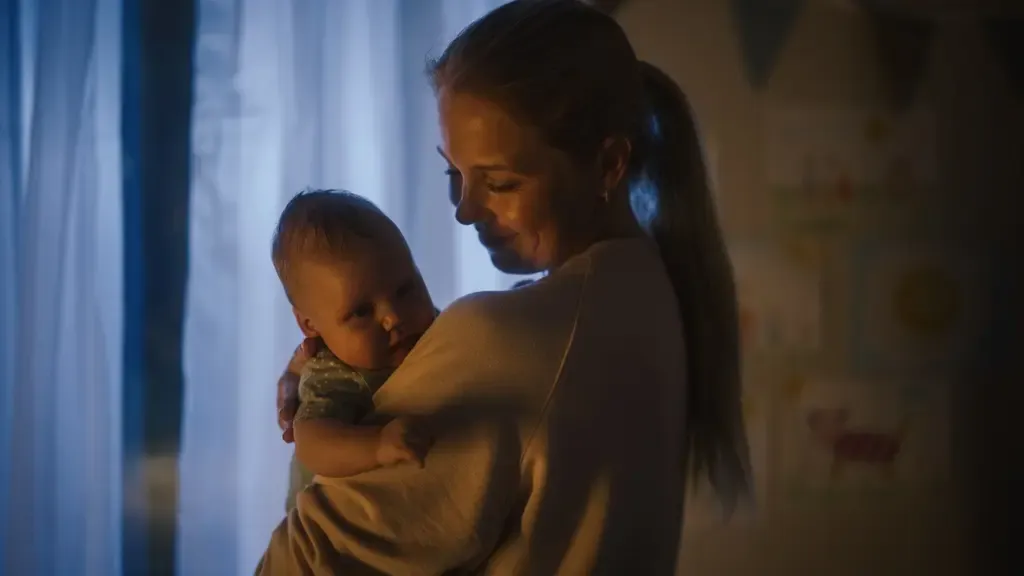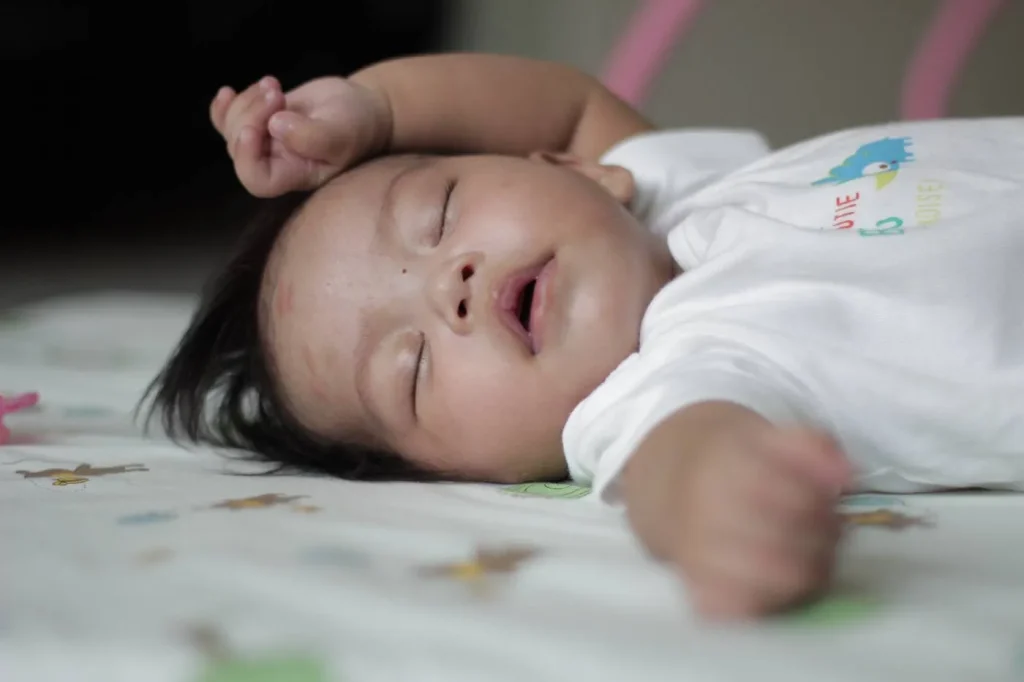In this guide, we will elaborate on gentle techniques, their advantages, and how one can manage their baby’s sleep schedule effectively. One of the most significant developmental periods for the parents, and the babies themselves, is the sleep training stage, and yet it always comes as a tough task, especially for parents who consider other methods very aggressive to the baby.
This takes into consideration the emotional well-being of a child, which is always the focus in the great bulk of routines while slowly introducing independence through techniques like self-soothing. Assistance in learning about the range of gentle sleep training techniques and their implementation can help every member of the family rest easier regardless if it’s a new parent or an older child who is having sleep issues
What is Gentle Sleep Training?
Gentle sleep training is a form of sleep discipline that incorporates ways in which the baby can be self-soothing which can get one to sleep without being wasted for extended periods. Unlike most of the traditional sleep training techniques, gentle approaches work towards providing comfort to the baby while at the same time reducing parental interference over some time.
This method is rather easy for the parents who are themselves distressed by adhering to the Cry-it-out or Ferber methods of sleep standardization that require leaving the infant unattended during crying sessions. Instead, gentle sleep training helps in building these favorable bonding conditions by having the parents take a gentler approach rather than letting the children cry.
How Gentle Sleep Training is Different from Other Methods
The main distinguishing feature of gentle sleep training is the attempt to keep the baby in a nurturing atmosphere rather than tormenting him. Techniques used in traditional methods such as Cry It Out leads to the baby being left to cry for long periods for example to the distress of the mother and even the child. On the other hand, there are no gentle methods that permit parents to meet their children’s needs and help them learn the art of sleeping alone gradually.
Parents are allowed to do this but only after providing minimal soothing support or once they have soothed the baby to some extent. This helps lessen the stress level of the baby and helps him learn the self-soothing ability when he thinks he is ready. In addition, gentle techniques also accommodate changes based on babies’ temperaments and ages hence proving to be a more adaptable technique.
Reasons to Use Gentle Sleep Training and Its Benefits:
- Less psychologic trauma: Gentle sleep training does not put emotional strain on the baby or mothers at any point since those involved seek to do everything that is within their powers.
- Usable for different temperaments: These techniques are not rigid methods but can be shaped to meet the needs of babies of different ages and habitude therefore so that all babies in turn can find their proper sleep atmosphere.
- Builds strong bonds between parents and children: Sleep training, when done in a non-nervous and reassuring way by the parents, allows a healthy attachment which in turn provides the baby with an assurance of safety.
- Promotes self-soothing sleep in the future: Quintessentially, baby-friendly sleep training practices are known to breed self-soothing ideas to infants, which have a positive influence on their sleeping patterns in the long run.
- Fewer screams and more soothe: Obviously, gentle sleep training contains much less screaming than several sleep training methods like Cry-It-Out, which both benefits the little one and the parents emotionally.
- Enhances sleep quality of all family members: Gentler methods of sleep training enhanced the quality and duration of sleep for all family members as they helped in the development of healthy sleeping patterns.
Generally Accepted Soft Approaches to Sleep Training
There are many soft approaches to training babies to sleep on their own that parents can choose from. The Parents also like popular methods which include the Default Method, Chair Method, Sleep Lady Shuffle, Fading Method and Pick Up Put Down Method.
The Pick Up, Put Down Method
The Pick Up, Put Down method is one of the most gentle forms of sleep training known to all parents. In this method, parents take up their baby when they are crying to comfort them and put them back down when the baby is calm. This method is practiced continuously until the baby learns to self-soothe and sleep on his own.
The baby will learn to tolerate being put in the cot when waking so long as they are not uncomfortable, making it easier for them to learn to put themselves to sleep without having to be carried. Eventually, a time comes whereby babies will self-soothe and cry very little leading to sleep being more of a solo exercise than dependent.

Pros and Cons
Pros:
This method allows parents to be able to make their babies comfortable without letting the babies develop a habit of sleeping only if held hence the Pick Up, Put Down method. This often works best for very young infants who have never been used to sleeping independently.
Furthermore, it ensures that this method develops a positive sleep association for the infant to be mindful of that their parents are around.
Cons:
This technique can take time especially at the beginning stages because often the parent will have to pick the baby up put them down several times before the child is settled. For a few babies, this motion may get to be tiring, thereby inhibiting the baby from sleeping easily.
And, this approach will call for a lot of consistency and patience from parents, as the outcome will span over weeks.
The Chair Method
The Chair Method is one more moderate sleep training method where the presence of a parent disappears slowly but surely over days. Parents of sleeping babies sit in a chair placed beside the baby’s crib in this method of sleep training. The next morning, the mother sits in a chair beyond the two-foot mark and repeats the same routine until the husband and wife can leave the room for the night.
The baby gets relieved of the stress of being close to an adult, though the adult is still in and engulfs the baby slowly. This works well for parents who wish to instill a strong feeling of safety in their child while helping the child develop sleeping independently.
Pros and Cons
Pro’s
The Chair Method has been far more effective with the’ no’ crying than other methods. For parents who wish to participate on sleep training of their baby, it helps remain near the child while he gets trained. Parents can patiently wait until the complete independence of the child is ensured to help them make evaluations.
This method also allows the parents to check on the baby whenever they feel the baby is upset thereby lessening the chances of them crying for a long duration.
Con’s
The downside is optimizing the above techniques may take time, and co-sleeping may be very easy later becoming hard to break. There may be a several-week delay when that child gets used to sleeping without a parent in the room.
Also in some cases, it becomes easier for the babies to get used to sighting the parent in the chair without actually conditioning more so moving to the next step in the procedure.
The Sleep Lady Shuffle
Kim West, The Sleep Lady Shuffle creator, emphasizes the superiority of gentle sleep training and has developed an organizational approach that combines elements of Pick Up Put Down and Chair methods. Parents sit by the side of the crib and provide verbal and tactile reassurance without picking the baby up.
Each night the parent moves a little bit farther away from the crib until the parent can exit the room altogether. The goal of this approach is constancy and soothing the baby rather than lulling or rocking the baby, which the baby will become dependent on, without developing the above behaviors.
Pros and Cons
Pro’s
The Sleep Lady Shuffle combine will work at different ages and stages making it very flexible for the parents. It provides parents clear protocol on what they should do when they don’t know how to go on with sleep training.
Also, the methods stimulate gradual changes which makes adjustments easy for the parent as well as the child.
Con’s
The greatest weakness or rather, grievance that is normally leveled against the Sleep Lady Shuffle is that it is quite rigid and requires a lot of discipline. For instance, parents have to follow the method religiously, and every night move farther and farther from the child and not fall back into other comforting habits like rocking a child, feeding Them to sleep, etc.
If parents have problems with consistency, the method may take longer to work or simply not work at all.
Fading Method
The Fading Method is another step by step technique that requires parents to assist the baby in a gradual process at the bedtime routine. For example, if a parent usually puts the baby to sleep by rocking them every night, they would slowly back down the amount of rocking done at night until the baby does not need to be rocked to sleep at all.
This helps the child cope with the new changes as they go, hence reducing stress. Fading also works with many other sleep associations, including breastfeeding and cuddling the baby to sleep, so it can be considered as one of the most versatile gentle sleep training strategies.

Pros and Con’s
Pro’s
One of the strengths of the Fading Method is that it is entirely parent-friendly, meaning that each parent can manipulate the method because of their baby’s needs and sleep prerequisites. It is a less abrupt approach and therefore is likely to result in little or no ‘crying it out.
This method helps the baby to be comfortable sleeping independently gradually and may therefore be effective in the long run.
Con’s
Since the Fading Method allows the parents to ease their way out of the process, this means that it would take quite some time before positive results can be reviewed. It is a trial-and-error process and as such, will take quite some time before the parents enjoy the ‘fruits of their labor’.
Furthermore, even if parents implement measures to minimize their intervention, the baby may still end up taking a longer time figuring out how to fall asleep without their involvement.
How to Create a Gradual Sleep Training Routine?
The focus here is on the gradual sleep training method and the sleep schedule is of utmost importance. Babies love consistency in all aspects of their lives and through this, parents can help their baby have a sense of when to go to bed.
Gradual Sleep Training Technique for 6-Month Baby
Six months is the period when the majority of babies will most likely start gentle sleep training for they on the other hand are beginning to sleep through the night less usually waking up for food in the night. A 6-month-old knows that during the day, she/he can take 2 or 3 naps, and come bedtime, there are consistent activities that happen.
Parents can start to implement gentle techniques like the Pick-Up, Put Down method, or the Chair Method at this point. These strategies help the child slowly adapt to sleeping by themselves with the parents still present to assist them.
Gentle Sleep Training for Baby’s 9 Months or Older
By nine months, sleep regression is common for babies as babies are learning new developmental skills like crawling or standing, which are reason enough to push some sleeping patterns aside. Such alterations may be disruptive in the short term, however, gentler sleep training techniques such as the Sleep Lady Shuffle can be used to provide that stability.
At this age, a baby, as follows, is likely to sleep through for one or two naps during the day with average concern for a consistent bed time routine any night. In as much as it is a time of regressions, parents must remain calm and escutcheon their gradual methods of calming the baby.

Gentle Sleep Training for Baby for 1-Year-Olds
Sometime after a baby’s first year, they will often be cutting back to one or no naps now and will probably fight sleep even more deeply than before because of their developing maturity. At this stage, a routine is essential, as is the ability to give boundaries using moderating sleep training strategies such as the Fading Method or Sleep Lady Shuffle.
At this age, the conventional trends state that a one-year-old can have a better grasp of the surroundings, therefore incorporating soothing activities such as reading during the bedtime routine can act as a cue for sleep.
When Is the Right Time for Gentle Sleep Training
It is therefore very important to know sleeping practices timelines in order to achieve maximum efficiencies.
Indicators of Baby Readiness
- Your baby readily falls asleep alone for short durations.
- They exhibit the ability to self-comfort such as thumb sucking or holding a soft toy or similar.
Adjusting According to the Bureau
Parents would be more involved in the sleeping patterns of the younger children whereas the older babies are capable of having longer sleep without assistance. The non-cry methods of increasing the child’s sleep can be adapted to the age of the child.
Common Problems Associated with the Training and Its True Resolution
Even when ‘gentle’ sleep training is used, it may still present some problems along the way.
What If Gentle Sleep Training Isn’t Working?
If, after several weeks, there doesn’t seem to be any noticeable improvement with gentle sleep training, it is time one is just looking at the right direction. Seeking the help of a physician and or a sleep specialist would help figure out if there are any medical problems disrupting sleep like sleep apnea or gastroesophageal reflux.
They may also recommend changes to the sleep training approach that would address the baby’s age and personality changes. Even small changes in the bedtime or the environment can help improve sleep in a short time. However, it is important to remember that each child is very different and each responds to gentler methods of (sleep) training at his own pace.
Dealing with Injuries and Sleep Regression
As development progresses, there often appears a sleep regression, which is sometimes associated with a growth spurt or a developmental milestone. These episodes can throw off the momentum gained during sleep training for a short period. They typically occur around certain ages like 4, 8, or 12 months, and they have descriptive terms with ages 4, 8, 12 months, etc., and cause interruptions to sleep habits.
In such situations, although there is a need to maintain the child’s sleeping schedule, it is also necessary to make allowances and provide help or change the timing of naps as appropriate. This phase usually lasts for a few weeks; it may not be the easiest but based on the child’s character, the child should get back to the habitual sleep structure with some time and effort.
Conclusion
A gentle sleep training technique is thoughtful and fair and caters to the emotional health of the parent as well as that of the baby. While this is generally less aggressive than harsher approaches to sleep training, it achieves healthy sleeping habits without disengaging the parent.
With the help of gentle methods, parents will be able to help their babies learn how to self-soothe gradually after which sleep independently for longer periods. Though the duration of this process may be more with more patience required from the parents, the benefits of a well-rested child as well as a calm home are definitely worth it.
FAQs on Gentle Sleep Training
Q: How soon can one commence gentle sleep training?
A: Gentle sleep training can begin as early as four to six months, as babies start learning to self-soothe. However, it can also be adapted for older babies depending on their developmental stage and readiness. Each baby is different, so it’s important to follow their cues and adjust the process accordingly.
Q: How long will it take for gentle sleep training to work?
A: The duration for gentle sleep training to show results varies based on the baby’s temperament, the method used, and how consistent parents are. Some parents may see changes in a few weeks, while others might take months. Gentle sleep training often takes longer to show results compared to more intensive methods, but it can be more sustainable in the long run.
Q: Will it result in the baby crying during the gentle sleep training?
A: Gentle sleep training minimizes crying by allowing parents to gradually reduce intervention over time. Unlike methods such as Cry-It-Out, gentle sleep training encourages parents to meet the baby’s needs without leaving them to cry for long periods. The goal is to promote independent sleep without unnecessary distress.
Q: Can I use gentle sleep training for naps as well as for night sleep?
A: Yes, gentle sleep training can be applied to both naps and nighttime sleep. The same techniques should be used consistently to create a healthy sleep routine. While naps may present more challenges at first, over time and with consistency, your baby can adapt to the same gentle methods used for nighttime sleep.
Q: What should I do when my baby is teething or sick during gentle sleep training?
A: During illness or teething, it’s okay to offer extra comfort, such as more frequent holding or feeding. Gentle sleep training can be temporarily adjusted, and once your baby is feeling better, you can return to the routine to help re-establish healthy sleep patterns.

Russell F. Jones, holding a Master in psychology from the University of Florida. He writes for Smart Parent Solutions, offering practical advice on parenting and child development. His engaging content helps parents navigate family life with confidence and ease. Russell enjoys sharing his knowledge and spending quality time with his family.
